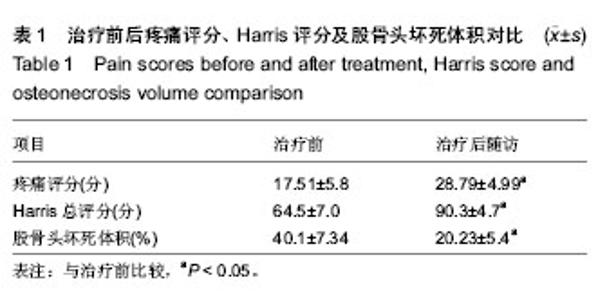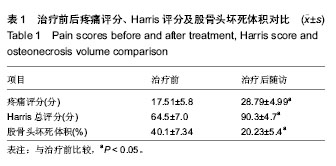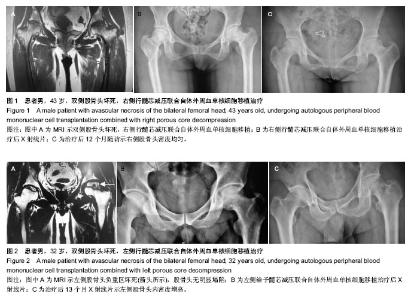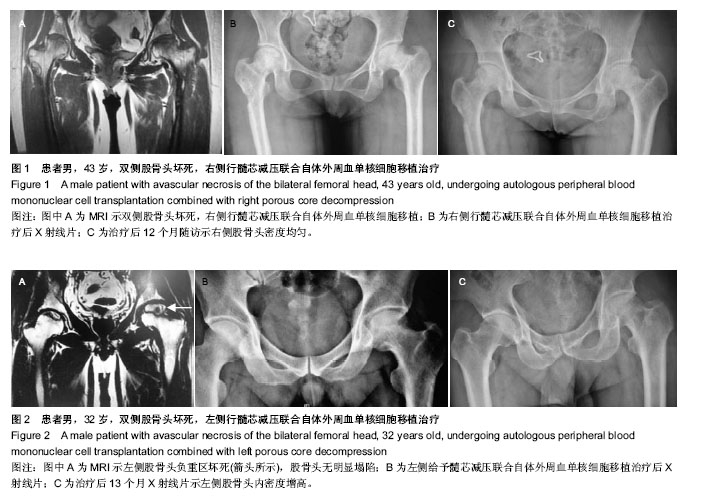| [1] 孙伟,李子荣,王佰亮,等.髓芯减压加自体骨髓干细胞移植治疗股骨头坏死的早期随访结果[J].中国组织工程研究与临床康复, 2008,12(12):2231-2234.
[2] 乔巨峰,高飞,汤奇,等. 髓芯减压及自体外周血干细胞移植治疗成人早期股骨头坏死的临床观察[J].中国骨与关节外科,2010, 3(6):458-461.
[3] Gangji V, Hauzeur JP, Schoutens A,et al.Abnormalities in the replicative capacity of osteoblastic cells in the proximal femur of patients with osteonecrosis of the femoral head.J Rheumatol. 2003;30(2):348-351.
[4] 梁红锁,黄克,李林,等. 微创细针多孔髓芯减压联合自体骨髓间充质干细胞移植治疗早期股骨头缺血性坏死[J].中国现代药物应用,2014,8(19):456-457.
[5] 孔凡国,李国文,韩松辉. 经皮细针多孔髓芯减压术联合持续动脉内药物灌注治疗早期股骨头缺血性坏死[J].中医正骨,2011, 23(7):39-41.
[6] 中华医学会骨科分会显微修复学组,中国修复重建外科专业委员会骨缺损及骨坏死学组.成人股骨头坏死诊疗标准专家共识[J].中国骨与关节外科,2012,5(2):185-192.
[7] 贾岩波,刘万林,任逸众.激素性股骨头坏死发病机制中细胞凋亡的研究进展[J].中国组织工程研究,2012,16(13): 2444-2450.
[8] 史跃,尹文洲,陈启忠,等.自体骨髓间充质干细胞动脉灌注联合局部注射治疗股骨头坏死[J].中国组织工程研究与临床康复, 2011,15(6):1065-1069.
[9] Gangji V, De Maertelaer V, Hauzeur JP.Autologous bone marrow cell implantation in the treatment of non-traumatic osteonecrosis of the femoral head: Five year follow-up of a prospective controlled study.Bone. 2011;49(5):1005-1009.
[10] 曾建春,樊粤光,曾意荣,等.股骨头髓芯减压植骨腓骨支撑联合自体外周血干细胞移植治疗股骨头坏死初步研究[J].新中医, 2014, 46(8):909-910.
[11] 刘保一,赵德伟.血管内皮细胞生长因子体外修饰骨髓基质干细胞关节镜下回植治疗兔股骨头坏死的研究[J].中华医学杂志,2009,89(37):2629-2733.
[12] 孟祥晖,王万明.股骨头坏死的保头手术治疗[J].中国矫形外科杂志,2011,19(4):308-310.
[13] Lavernia CJ, Sierra RJ.Core decompression in atraumatic osteonecrosis of the hip.J Arthroplasty. 2000;15(2):171-178.
[14] Aigner N, Schneider W, Eberl V,et al.Core decompression in early stages of femoral head osteonecrosis--an MRI-controlled study.Int Orthop. 2002;26(1):31-35.
[15] Wang BL, Sun W, Shi ZC,et al.Decreased proliferation of mesenchymal stem cells in corticosteroid-induced osteonecrosis of femoral head.Orthopedics. 2008;31(5):444.
[16] 李忠,陈歌,王治,等.髓芯减压复合自体骨髓间充质干细胞移植治疗股骨头缺血性坏死[J].中国矫形外科杂志,2012,20(5): 411-414.
[17] 梁红锁,黄克,李林,等.钽棒植入联合自体骨髓间充质干细胞移植治疗早期股骨头缺血性坏死[J].医学理论与实践,2014,27(19): 2534-2535.
[18] 李杨,冯世庆.早期股骨头缺血性坏死治疗:髓芯减压并钽棒优于并植骨[J].中国组织工程研究,2014,18(5):815-820.
[19] 申文龙,杜丽,张辉,等.髓芯减压植骨自体骨髓间充质干细胞移植治疗早期股骨头缺血性坏死[J].中国骨与关节损伤杂志,2011, 26(4):353-354.
[20] 唐烽明,王景贵,赵栋,等.激素药源性股骨头坏死及骨质疏松49例中期分析[J].中国骨与关节损伤杂志,2012,27(2):106-108.
[21] 方志,陈曦,刘树平.髓芯减压结合自体皮质支撑骨及松质颗粒骨植骨治疗成人股骨头缺血性坏死[J].中国修复重建外科杂志, 2010,24(3):266-269.
[22] 周炎.髓芯减压植骨术治疗早期股骨头缺血性坏死的临床疗效观察[D].武汉:湖北中医学院,2009.
[23] 陶家安.髓芯减压配合中药分型治疗股骨头缺血性坏死[J].中国民族民间医药,2011,20(16):89,93.
[24] 李富新.钽棒植入治疗早期股骨头坏死的临床疗效观察[J].当代医学,2011,17(19):55-57.
[25] 田庆海.股骨头缺血性坏死的临床治疗观察[J].中国实用医药,2011,6(23):74-75.
[26] 胡跃春,曾秋华,刘晓明.早期股骨头缺血性坏死的MRI诊断[J].罕少疾病杂志,2011,18(3):44-45.
[27] Dailiana ZH, Toth AP, Gunneson E,et al.Free vascularized fibular grafting following failed core decompression for femoral head osteonecrosis.J Arthroplasty. 2007;22(5): 679-688.
[28] 康鹏德,裴福兴,杨静,等.骨髓脂肪细胞向骨细胞的转分化[J].中国组织工程研究与临床康复,2011,15(1):17-22. |



